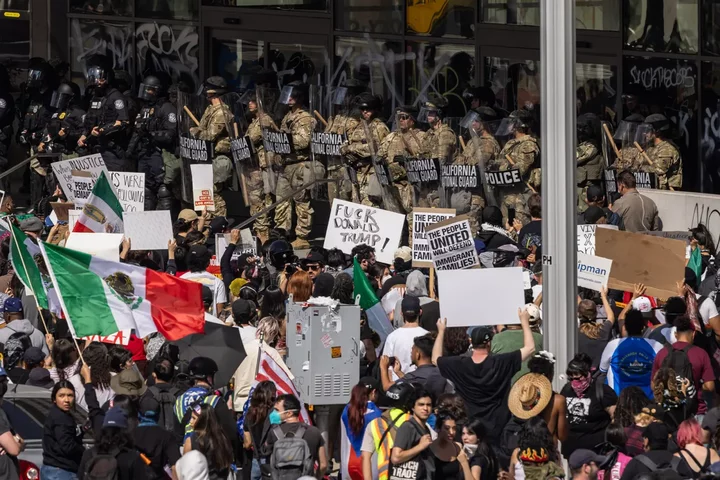Demonstrators protest against recent ICE immigration raids as National Guard officers stand guard in front of a federal building in Los Angeles on June 9, 2025. Photo by Ted Soqui for CalMatters
###
This story was originally published by CalMatters. Sign up for their newsletters.
###
Donald Trump can continue to control the National Guard in California for the time being after a panel of judges from the 9th Circuit Court of Appeals determined he followed the law in deploying troops to Los Angeles.
The order is the latest in a fast-moving legal saga playing out over Trump’s decision to call up the National Guard and U.S. Marines to the Los Angeles area in response to protests after federal immigration law enforcement agents began worksite raids and arrests two weeks ago. California’s Democratic leadership, led by Gov. Gavin Newsom, has called the deployment unnecessary and illegal.
Their order in a lawsuit filed by Newsom contesting the deployment isn’t surprising; the panel signaled an openness to the Trump administration’s legal arguments during a legal hearing on Tuesday.
In court earlier this week, attorneys from the Trump administration argued the president’s deployment was “unreviewable” by courts.
The appeals court judges disagreed that the decision was beyond the reach of the judicial branch, but found the president had a legitimate interest in protecting federal employees when he called up the troops.
“The undisputed facts demonstrate that before the deployment of the National Guard, protesters ‘pinned down’ several federal officers and threw ‘concrete chunks, bottles of liquid and other objects’ at the officers.”
Two of those judges were appointed by President Trump in his previous term.
What happens next could take one of several turns. On Friday a lower court judge, Charles Breyer, will hold a hearing on whether to again return the troops to Newsom through a preliminary injunction.
Trump deployed the troops through a presidential memo on June 7 and cited a rarely used federal statute permitting a president to deploy the National Guard in times of invasion, domestic rebellion or the inability for the federal government to carry out its laws. Trump’s order was for 60 days and technically applied to all of the state Nation Guards in the U.S.
Basically, the battle over whether federal troops can remain in Los Angeles is operating on three parallel tracks — the temporary restraining order from last week, Friday’s hearing and the full merits of the case through a prolonged trial. Technically, the government lawyers for Trump and Newsom can ask for appeals on all three tracks.
For Newsom’s legal team to prevail in Friday’s hearing, they’ll have to clear a higher threshold of scrutiny than they did when they initially won back the National Guard last week, albeit for a few hours. That’s because anyone seeking a preliminary injunction must demonstrate that the merits of their arguments will likely prevail in the full trial.
The appeals court’s decision could influence Breyer’s thinking, legal thinkers said, even if he initially signalled support for the Newsom administration’s arguments.
“It’s kind of hard to disentangle the two processes when we think about how judge Breyer will be weighing” the preliminary injunction hearing,” because a lot of that’s going to be informed by what these higher level courts decide,” said Christopher Mirasola, an assistant law professor at the University of Houston Law Center.
No matter what Breyer does after Friday, it’ll likely quickly go back to the appeals court. And if the appeals court keeps halting the lower court’s orders, Trump keeps the National Guard for the duration of the lower court’s full trial.
Would the Newsom team try to appeal the injunction with the Supreme Court?
On one hand, “why not shoot your shot when you got the opportunity, right?” asked Mirasola rhetorically. But there’s a chance the high court comes back with such a strong opinion favoring the Trump administration that it could “substantively affect how judge Breyer treats the merits of the case.”

CLICK TO MANAGE